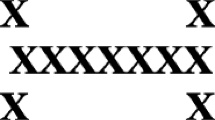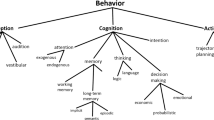Abstract
This study addresses mechanisms for the generation and selection of visual behaviors in anamniotes. To demonstrate the function of these mechanisms, we have constructed an experimental platform where a simulated animal swims around in a virtual environment containing visually detectable objects. The simulated animal moves as a result of simulated mechanical forces between the water and its body. The undulations of the body are generated by contraction of simulated muscles attached to realistic body components. Muscles are driven by simulated motoneurons within networks of central pattern generators. Reticulospinal neurons, which drive the spinal pattern generators, are in turn driven directly and indirectly by visuomotor centers in the brainstem. The neural networks representing visuomotor centers receive sensory input from a simplified retina. The model also includes major components of the basal ganglia, as these are hypothesized to be key components in behavior selection. We have hypothesized that sensorimotor transformation in tectum and pretectum transforms the place-coded retinal information into rate-coded turning commands in the reticulospinal neurons via a recruitment network mimicking the layered structure of tectal areas. Via engagement of the basal ganglia, the system proves to be capable of selecting among several possible responses, even if exposed to conflicting stimuli. The anatomically based structure of the control system makes it possible to disconnect different neural components, yielding concrete predictions of how animals with corresponding lesions would behave. The model confirms that the neural networks identified in the lamprey are capable of responding appropriately to simple, multiple, and conflicting stimuli.
Similar content being viewed by others
References
Braitenberg V (1984) Vehicles: experiments in synthetic psychology. MIT Press, Cambridge
Brocard F, Ryczko D, Fénelon K, Hatem R, Gonzales D, Auclair F, Dubuc R (2010) The transformation of a unilateral locomotor command into a symmetrical bilateral activation in the brainstem. J Neurosci 13(30(2): 523–533
Cabelguen JM, Ijspeert A, Lamarque S, Ryczko D (2010) Axial dynamics during locomotion in vertebrates lesson from the salamander. Prog Brain Res 187: 149–162
Cornide-Petronio ME, Barreiro-Iglesias A, Anadón R, Rodicio MC (2011) Retinotopy of visual projections to the optic tectum and pretectum in larval sea lamprey. Exp Eye Res 92(4): 274–281
Chiel HJ, Ting LH, Hartmann MJ, Hartmann MJ (2009) The brain in its body: motor control and sensing in a biomechanical context. J Neurosci 29(41): 12807–12814
De Miguel E, Rodicio MC, Anadon R (1990) Organization of the visual system in larval lampreys: an HRP study. J Comp Neurol 302: 529–542
Dubuc R, Brocard F, Antri M, Fénelon K, Gariépy JF, Smetana R, Ménard A, Le Ray D, VianaDi Prisco G, Pearlstein E, Sirota MG, Derjean D, St-Pierre M, Zielinski B, Auclair F, Veilleux D (2008) Initiation of locomotion in lampreys. Brain Res Rev 57(1): 172–182
Eaton RC, Lee RKK, Foreman MB (2001) The Mauthner cell and other identified neurons of the brainstem escape network of fish. Prog Neurobiol 63(4): 467–485
MB (1993) A combined neuronal and mechanical model of fish swimming. Biol Cybern 69: 363–374
Grillner S, Grillner S (1999) Simulations of neuromuscular control in lamprey swimming. Philos Trans R Soc Lond B Biol Sci 354: 895–902
Finkenstädt T, Ewert JP (1983) Visual pattern discrimination through interactions of neural networks: a combined electrical brain stimulation, brain lesion, and extracellular recording study in Salamandra salamandra. J Comp Physiol 153(1): 99–110
Gahtan E, Tanger P, Baier H (2005) Visual prey capture in larval zebrafish is controlled by identified reticulospinal neurons downstream of the tectum. J Neurosci 25(40): 9294–9303
Gewaltig MO, Diesmann M (2007) NEST (Neural Simulation Tool). Scholarpedia 2(4): 1430
Grillner S, Georgopoulos AP, Jordan LM (1997) Selection and initiation of motor behavior. In: Stein PSG, Grillner S, Selverston AI, Stuart DG (eds) Neurons, networks, and motor behavior. MIT Press, Cambridge, pp 3–19
Grillner S, Kozlov A, Dario P, Stefanini C, Menciassi A, Lansner A, Hellgren Kotaleski J (2007) Modeling a vertebrate motor system: pattern generation, steering and control of body orientation. Prog Brain Res 165: 221–234
Grillner S, Wallén P, Saitoh K, Kozlov A, Robertson B (2008) Neural bases of goal-directed locomotion in vertebrates – an overview. Brain Res Rev 57(1): 2–12
Groh JM (2001) Converting neural signals from place codes to rate codes. Biol Cybern. 85(3): 159–165
Harischandra N, Cabelguen J-M, Ekeberg Ö (2010) A 3D musculo-mechanical model of the salamander for the study of different gaits and modes of locomotion. Front Neurorobot 4: 112
Harischandra N, Knuesel J, Kozlov A, Bicanski A, Cabelguen JM, Ijspeert A, Ekeberg Ö (2011) Sensory feedback plays a significant role in generating walking gait and in gait transition in salamanders: a simulation study. Front Neurorobot
Heier P (1948) Fundamental principles in the structure of the brain. A Study of the brain of Petromyzon fluvilatis. Acta Anat [Suppl] VI:213
Ijspeert AJ (2008) Central pattern generators for locomotion control in animals and robots: a review. Neural Netw 21(4): 642–653
Ijspeert AJ, Arbib M (2000) Visual tracking in simulated salamander locomotion, from animals to animats. In: Meyer JA, Berthoz A, Floreano D, Roitblat H, Wilson SW (eds) Proceedings of the 6th international conference on the simulation of adaptive behavior (SAB2000). MIT Press, Cambridge, pp 88–97
Kamali Sarvestani I, Lindahl M, Hellgren-Kotaleski J, Ekeberg Ö (2011) The arbitration-extension hypothesis: a hierarchical interpretation of the functional organization of the basal ganglia. Front Syst Neurosci 5: 13
Johnson NS, Yun SS, Thompson HT, Brant CO, Li W (2009) A synthesized pheromone induces upstream movement in female sea lamprey and summons them into traps. Proc Natl Acad Sci USA 106: 1021–1026
Jones MR, Grillner S, Robertson B (2009) Selective projection patterns from subtypes of retinal ganglion cells to tectum and pretectum: distribution and relation to behavior. J Comp Neurol 517(3): 257–275
Jordan LM (1998) Initiation of locomotion in mammals. Ann NY Acad Sci 860: 83–93
Kennedy MC, Rubinson K (1977) Retinal projections in larval, transforming and adult sea lamprey Petromyzon marinus. J Comp Neurol 171: 465–480
Korn H, Faber DS (2005) The Mauthner cell half a century later: a neurobiological model for decision-making. Neuron 47(1): 13–28
Kosareva AA (1980) Retinal projections in lamprey (Lampetra fluviatilis). J Hirnforsch 21(3): 243–256
Kozlov et al. (2009) Simple cellular and network control principles govern complex patterns of behavior. PNAS
Lapicque L (1907) Recherches quantitatives sur l’excitation électrique des nerfs traitée comme une polarisation. J Physiol Pathol Gen 9: 620–635
Lee C, Rohrer WH, Sparks DL (1988) Population coding of saccadic eye movements by neurons in the superior colliculus. Nature 332(6162): 357–360
Le Ray D, Juvin L, Ryczko D, Dubuc R (2011) Supraspinal control of locomotion: the mesencephalic locomotor region. In: Gossard JP, Dubuc R, Kotla A (eds) Breath, walk and chew, the neural challenge: II. Prog Brain Res
Maier S, Walkowiak W, Luksch H, Endepols H (2010) An indirect basal ganglia pathway in anuran amphibians?. J Chem Neuroanat 40(1): 21–35
McHaffie JG, Stanford TR, Stein BE, Coizet V, Redgrave P (2005) Subcortical loops through the basal ganglia. Trends Neurosci 28: 401–407
Ménard A, Auclair F, Bourcier-Lucas C, Grillner S, Dubuc R (2007) Descending GABAergic projections to the mesencephalic locomotor region in the lamprey Petromyzon marinus. J Comp Neurol 501(2): 260–273
Meredith MA, Ramoa AS (1998) Intrinsic circuitry of the superior colliculus: pharmacophysiological identification of horizontally oriented inhibitory interneurons. J Neurophysiol 79(3): 1597–1602
Nieuwenhuys R, Nicholson C (1998) Lampreys, Petromyzontoidea. In: Nieuwenhuys R, ten Donkelaar HJ, Nicholson C (eds) The central nervous system of vertebrates. Springer, Heidelberg, pp 397–495
Petreska B (2004) A neural visuomotor controller for asimulated Salamander Robot. Dissertation. École Polytechnique Fédérale de Lausanne
Redgrave P, Prescott TJ, Gurney K (1990) The basal ganglia: a vertebrate solution to the selection problem?. Neuroscience 89(4): 1009–1023
Robertson B, Saitoh K, Ménard A, Grillner S (2006) Afferents of the lamprey optic tectum with special reference to the GABA input: combined tracing and immunohistochemical study. J Comp Neurol 499(1): 106–119
Roth G, Grunwald W (2000) Morphology, axonal projection pattern, and responses to optic nerve stimulation of thalamic neurons in the salamander Plethodon jordani. J Comp Neurol 428(3): 543–557
Saitoh K, Ménard A, Grillner S (2007) Tectal control of locomotion, steering, and eye movements in lamprey. J Neurophysiol 97(4): 3093–3108
Sánchez-Camacho C, Marín O, Ten Donkelaar HJ, González A. (2001a) Descending supraspinal pathways in amphibians: I. A dextran amine tracing study of their cells of origin. J Comp Neurol 434(2): 186–208
Sánchez-Camacho C, Marín O, Smeets WJ, Ten Donkelaar HJ, González A. (2001b) Descending supraspinal pathways in amphibians: II. Distribution and origin of the catecholaminergic innervation of the spinal cord. J Comp Neurol 434(2): 209–232
Sánchez-Camacho C, Martín O, Ten Donkelaar HJ, González A. (2002) Descending supraspinal pathways in amphibians: III. Development of descending projections to the spinal cord in Xenopus laevis with emphasis on the catecholaminergic inputs. J Comp Neurol 446(1): 11–24
Selset R, Doving KB (1980) Behaviour of mature anadromous char (Salmoalpinus L.) towards odorants produced by smolts of their own population. ActaPhysiol Scand 108: 113–122
Smetana R, Juvin L, Dubuc R, Alford S (2010) A parallel cholinergic brainstem pathway for enhancing locomotor drive. Nat Neurosci 13(6): 731–738
Stephenson-Jones M, Samuelsson E, Ericsson J, Robertson B, Grillner S (2011) Evolutionary conservation of the basal ganglia as a common vertebrate mechanism for action selection. Curr Biol 21(13): 1081–1091
Takakusaki K, Saitoh K, Harada H, Kashiwayanagi M (2004) Role of basal ganglia-brainstem pathways in the control of motor behaviors. Neurosci Res 50(2): 137–151
Takakusaki K (2008) Forebrain control of locomotor behaviors. Brain Res Rev 57(1): 192–198
Ullén F, Deliagina T, Orlovsky G, Grillner S (1995) Spatial orientation in the lamprey. II. Visual influence on orientation during locomotion and in the attached state. J Exp Biol 198(Pt 3): 675–681
Ullén F, Deliagina TG, Orlovsky GN, Grillner S (1997) Visual pathways for postural control and negative phototaxis in lamprey. J Neurophysiol 78(2): 960–976
van der Want JJ, Nunes Cardozo JJ, van der Togt C (1992) GABAergic neurons and circuits in the pretectal nuclei and the accessory optic system of mammals. Prog Brain Res 90: 283–305
Vesselkin NP, Ermakova TV, Repérant J, Kosareva AA, Kenigfest NB (1980) The retinofugal and retinopetal systems in Lampetra fluviatilis. An experimental study using radioautographic and HRP methods. Brain Res 195(2): 453–460
VianaDi Prisco G, Pearlstein E, Robitaille R, Dubuc R (1997) Role of sensory-evoked NMDA plateau potentials in the initiation of locomotion. Science 278: 1122–1125
VianaDi Prisco G, Pearlstein E, Le Ray D, Robitaille R, Dubuc R (2000) A cellular mechanism for the transformation of a sensory input into a motor command. J Neurosci 20: 8169–8176
Zelenin PV, Grillner S, Orlovsky GN, Deliagina TG. (2001) Heterogeneity of the population of command neurons in the lamprey. J Neurosci 21(19): 7793–7803
Zompa IC, Dubuc R (1998a) a) Diencephalic and mesencephalic projections to rhombencephalic reticular nuclei in lampreys. Brain Res 802(1-2): 27–54
Zompa IC, Dubuc R (1998) Electrophysiological and neuropharmacological study of tectoreticular pathways in lampreys. Brain Res 804(2): 238–252
Author information
Authors and Affiliations
Corresponding author
Additional information
This article forms part of a special issue of Biological Cybernetics entitled “Lamprey, Salamander Robots and Central Nervous System”.
Electronic Supplementary Material
The Below is the Electronic Supplementary Material.
Rights and permissions
About this article
Cite this article
Kamali Sarvestani, I., Kozlov, A., Harischandra, N. et al. A computational model of visually guided locomotion in lamprey. Biol Cybern 107, 497–512 (2013). https://doi.org/10.1007/s00422-012-0524-4
Received:
Accepted:
Published:
Issue Date:
DOI: https://doi.org/10.1007/s00422-012-0524-4




